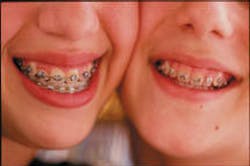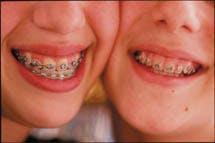"Brush four times a day?" "Floss?" No way!!
Photo by Barry Rosenthall at FPG International
Getting teen and preteen orthodontic patients to comply with a hygiene regimen is a challenge. A realistic approach — plus a little bribery — can help smooth the way.
by Barbara Alexander, RDH
Another beautiful day ... My preteen comes bouncing down the stairs with a cheery "good morning" and a peck on the cheek. While she clears the breakfast dishes and begins to wash them, she reminds me of her orthodontist appointment. Then she's off to brush and floss before school.
"Mom? Mom!" I open my eyes and see the face of my preteen contorted with embarrassment. "I can't believe you fell asleep," she states accusingly. "The doctor wants to talk to you."
Well, there are dreams. And then there's reality. In the life of a mom with a preteen or teen, the twain seldom meets. Consideration and cooperation are barely distinguishable qualities in the 11-to-21-year-old set. So how do we as hygienists enlist preteens and teens with braces to comply with our instructions? Should making them the ideal orthodontic patient be our aim, or do we settle for reality? What is the scoop on those permanent mandibular retainers? With the help of Pam Paladin of the American Academy of Orthodontists (AAO) and orthodontist, Dr. Jerome Jarosz of Arlington Heights, Illinois, I found the answers to these questions.
The ideal orthodontic patientWe all know by now that to achieve successful orthodontic treatment we all have to work as a team. The orthodontist, dentist, hygienist, parent, and, of course, the patient are the teammates. A successful treatment plan and accurate treatment time depends on compliance. A beautiful end result depends on plaque control; the hygienist is at the forefront of this battle. The patient must do the work, but it is our responsibility to guide our patients, as well as clean their teeth to help maintain their oral health during orthodontic treatment.Remember as you read the following that this is the "ideal orthodontic patient" segment according to the recommendations of the AAO and orthodontists. Adult and preteen/teen orthodontic patients should:
- Have cleanings every three to four months.
- Should not eat hard or sticky foods that result in loose or broken brackets or wires.
- Nutrition should be especially good during orthodontic treatment. As you know, movement of the teeth is due to forces pushing and pulling the teeth. As the tooth moves, bone breaks down, creating a spot for the tooth. Bone then refills where the tooth once was. Calcium, protein, and vitamins are crucial for this process to be successful.
- Brushing should be done four times a day, after every meal and at bedtime. If this can't be done, patients should at least rinse to remove food particles. Remind patients to change brushes frequently because they are less effective when bristles face opposite directions.
- Flossing should be done once a day. Of course, a floss threader is required equipment for this job. Flossing should be done when there is plenty of time.
- An interproximal brush should be used to help completely remove plaque and food particles from around the archwire and brackets.
- Wearing the required rubber bands and/or headgear is essential to stay on schedule.
Motivating and encouraging this group of patients is a great challenge for hygienists. Depending on the patient, one of two things will work: Bribing them, or appealing to their vanity.
Bribery. Orthodontists have picked up on the bribery aspect of motivation. In many offices, every time the patient comes in with good oral hygiene and the proper amount of movement has occurred (so they must have complied with rubber band/headgear instructions), they pick a prize or receive a token to be accumulated for a special prize. We can also institute this in our offices to keep them motivated in between orthodontic appointments. This way, we further the team effort.
Vanity. For some patients, a simple verbal reward of how great they look and how well they are doing is enough. For others it is not enough; you have to bring out the big guns. The big guns are the threats to their vanity. Explaining to them that their gums look sore and almost bloody will translate to "Oh gross." The second hit comes from what can happen to their teeth if they don't brush them well. The threat of bad breath is the biggest gun of all. Leaving food and plaque around braces causes bad breath. Most patients are very keen to avoid halitosis.
A word of advice: Save the big guns for those who are really lacking in the hygiene department and not trying at all. For those who are showing some effort bribery works much better.
What can happen during orthodontic treatment?Braces are plaque traps; an increase in plaque accumulation causes irritation to the gingiva resulting in gingivitis, or worse — periodontitis. It is a shame that patients spend the time and money to straighten their teeth only to endure further treatment for gingivitis or periodontitis. Here is where you must give them the "team effort" speech and send them home with an arsenal of tools to use. Also, promise that you will help them by cleaning their teeth more frequently. During recall appointments, it is helpful to include the use of a Cavitron to flush the gingival tissue with an antimicrobial, followed by instructions for rinsing at home, too.Another result of plaque accumulation around braces is decalcification, the permanent white lines or spots left on teeth. Here is the perfect occasion to appeal to a patient's vanity. They will have straight teeth, but in the end be unhappy because of permanent reminders of their poor oral hygiene.
Those of you who have associated TMD with orthodontic treatment may be interested to know that you are not alone in this thought. Research has been done and has concluded that there is no correlation between orthodontic treatment and TMD.
Life after braces
Most of us have had adult patients complain about teeth shifting. This is most alarming for those adults who have had braces. We lose bone density with age. The jaw is no exception. Add to that the forces of bruxing, cheeks, and tongues can affect the integrity of the occlusion.
To combat relapse, orthodontists use retainers. According to the AAO, "wearing your retainer as instructed is the key to maintaining the success of your orthodontic treatment." Retainers can be permanent or removable. The trend in orthodontics today is moving away from permanent retainers because it is so difficult for patients to maintain them. Permanent retainers are typically placed on the lingual of the mandibular anteriors where most of the calculus accumulates. Calculus buildup and inaccessibility can add up to periodontal problems.
According to Dr. Jarosz, removable retainers should be worn nightly for two years after orthodontic treatment is complete or until the wisdom teeth have completely erupted (or have been extracted). Following this, the retainer should be tried two to three times a month to ensure the teeth are still in alignment. If shifting has occurred, the orthodontist should be contacted for an appointment.
As hygienists, we have our jobs cut out for us to motivate and maintain orthodontic patients. If you are a fellow parent of a preteen/teen, enforcing good oral hygiene is the tip of the iceberg on the battles ahead. Extending time and effort towards this group of patients is worthwhile because it is another path to our goal of creating healthy and beautiful smiles.
Barbara Alexander, RDH, practices in Buffalo Grove, Ill. She is also the owner of Day and Night Desktop Writers, a graphic design company. She can be contacted via email at [email protected]
Tools for the orthodontic patient
Electric toothbrushes — Typically, electric toothbrushes just do a better job. Some electric toothbrushes help to remove food with sonic waves and/or water even if the bristles do not touch the debris. Another plus to electric toothbrushes is that the bristles are more resilient to the sharp edges of the brackets.
Flossing — Floss threaders are the most commonly used flossing instruments for braces. Flossing with braces is a hassle! One product on the market has a plastic tip on the end of the floss so there is no threading to do. Automatic flossers on the market have a stiff fiber that can be placed between two teeth and do not need to enter through the contact. The easier we make flossing, the better! Recommending flossing a quadrant a day may seem more achievable. Some effort towards plaque removal is better than no effort.
Water irrigator — This piece of equipment is a favorite of patients. It is quick, easy, not very time consuming and the patient feels clean in the end. While it is great for removing food from around brackets and wires, it does not remove plaque. Patients tend to want to replace flossing with the water irrigator; you must stress the fact that it will not remove the plaque and bacteria that cause periodontal problems.
Fluoride rinse — With the increase in trapped bacteria, food, and plaque comes a potentially equal increase in decay. You may have to do some research on which fluoride rinse to recommend. The market is flooded with many different types and concentrations of fluoride rinses.
Proxabrush — The AAO recommends that the proxabrush be used in addition to all the other tools. It is a handy tool but patients also often substitute this one for flossing. If you recommend the proxabrush, it might be best to suggest this as a tool for work or school when flossing may not be convenient.

